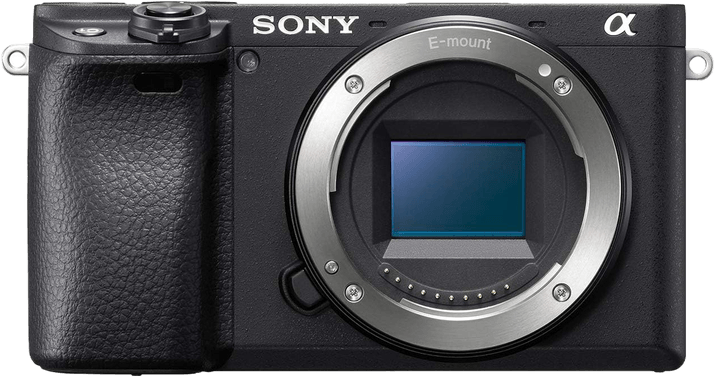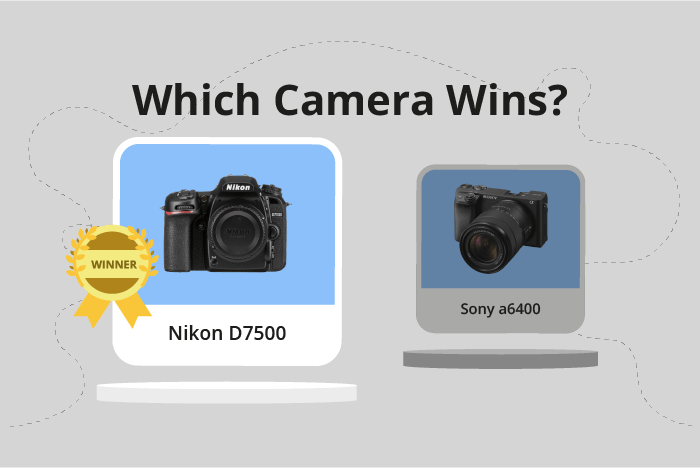Nikon D7500 vs Sony a6400 Comparison
Nikon D7500

Sony a6400

The Nikon D7500 and the Sony a6400 both scored 70/100 in our evaluation, showcasing their similar performance. These cameras share some common specifications, such as their announcement years (2017 for the D7500 and 2019 for the a6400) and their launch prices ($1250 for the D7500 and $900 for the a6400).
The Nikon D7500, a DSLR camera, excels with its larger size (136 x 104 x 73mm) and heavier weight (720g / 1.59lbs), which may be preferable for photographers who appreciate a sturdier build. On the other hand, the Sony a6400, a mirrorless camera, boasts a more compact design (120 x 67 x 60mm) and lighter weight (403g / 0.89lbs), making it an ideal choice for those who value portability.
Both cameras have their unique strengths, with the D7500 offering a robust build and the a6400 providing a lightweight, compact option. Ultimately, the choice between them depends on individual preferences and priorities.
Nikon D7500 vs Sony a6400 Overview and Optics
The Nikon D7500 and the Sony a6400 both received an optics score of 68/100, indicating a tie in terms of optics performance. Both cameras have several features in common, including a CMOS sensor, APS-C sensor size, and the absence of image stabilisation. However, there are differences between the two cameras that make one better in certain aspects.
The Nikon D7500 has a DXOMARK sensor score of 86, which is higher than the Sony a6400’s score of 83. This means that the D7500’s sensor performs better, providing improved image quality and low-light performance. Additionally, the camera has an Expeed 5 processor, which contributes to its powerful performance.
On the other hand, the Sony a6400 has a higher megapixel count at 24.2 compared to the D7500’s 20.9 megapixels. This allows the a6400 to capture more detail in images and provide greater resolution. Furthermore, the a6400 has a faster shooting speed of 11 frames per second, compared to the D7500’s 8 frames per second. This makes the a6400 better suited for capturing fast-moving subjects and action shots.
The Nikon D7500 and Sony a6400 have different lens mounts, with the D7500 using the Nikon F DX mount and the a6400 using the Sony E mount. This means that each camera is compatible with a different range of lenses, which could influence a photographer’s choice depending on their existing lens collection or preference for a specific brand.
Considering the optics performance, the Nikon D7500 and Sony a6400 are closely matched, with each camera having its own strengths. The D7500’s better sensor performance and the a6400’s higher resolution and faster shooting speed make both cameras suitable for different photography needs. Ultimately, the choice between the two cameras will depend on the individual photographer’s preferences and requirements.
Nikon D7500 vs Sony a6400 Video Performance
The Sony a6400 outperforms the Nikon D7500 in video capabilities with a score of 91/100, compared to the Nikon’s 70/100. Both cameras share a maximum video resolution of 4K and dimensions of 3840 x 2160, as well as built-in time-lapse functionality.
The Sony a6400 excels with its maximum video frame rate of 120fps, significantly higher than the Nikon D7500’s 30fps. This higher frame rate allows for smoother and more detailed slow-motion footage, giving users a greater range of creative possibilities. The Sony’s superior video score is a direct result of its enhanced frame rate capabilities.
The Nikon D7500, on the other hand, has no specific advantages over the Sony a6400 in terms of video capabilities. Both cameras share the same resolution, dimensions, and time-lapse features, but the Nikon falls short in frame rate performance.
In comparing the video capabilities of the Nikon D7500 and Sony a6400, it is clear that the Sony is the more capable camera for videographers. Its higher frame rate provides smoother and more versatile video recording options, while the Nikon offers no unique advantages in this area. Users seeking a camera with strong video performance should opt for the Sony a6400, as its superior frame rate capabilities and overall video score make it the better choice.
Nikon D7500 vs Sony a6400 Features and Benefits
The Nikon D7500 wins the features comparison with a score of 83/100, while the Sony a6400 follows closely with a score of 81/100. Both cameras share several common specifications that contribute to their high scores. These include having a touchscreen, a flip screen, WIFI, and Bluetooth capabilities. Additionally, neither camera has GPS functionality.
The Nikon D7500 edges out the Sony a6400 with its slightly larger screen size of 3.2 inches and a marginally higher screen resolution of 922,000 dots. These factors enhance the user experience, making it easier to compose and review images on the D7500. The Sony a6400, on the other hand, has a slightly smaller 3-inch screen and a screen resolution of 921,600 dots.
Despite trailing in the overall score, the Sony a6400 has its advantages. It is known for its compact size and lightweight design, making it more portable and convenient for travel or street photography. This aspect could be more appealing to some users, despite the minor differences in screen specifications.
To conclude, the Nikon D7500 takes the lead in features with a larger screen and higher resolution, providing a better user experience. However, the Sony a6400 remains a strong competitor, offering a more compact design that could be beneficial for certain users. Ultimately, the choice between these two cameras will depend on individual preferences and priorities.
Nikon D7500 vs Sony a6400 Storage and Battery
The Nikon D7500 outperforms the Sony a6400 in storage and battery with a score of 43/100 compared to 37/100. Both cameras have one memory card slot and accept SD, SDHC, and SDXC cards. However, the Sony a6400 also supports Memory Stick Duo (UHS-I compatible) cards.
The Nikon D7500 excels in battery life, providing 950 shots per charge with its EN-EL15a battery. In contrast, the Sony a6400 offers only 410 shots using the NP-FW50 battery. This advantage makes the D7500 more suitable for extended shooting sessions.
On the other hand, the Sony a6400 offers USB charging, which the Nikon D7500 lacks. This feature allows for convenient charging on-the-go using portable power banks or other USB sources.
Taking these factors into account, the Nikon D7500’s superior battery life makes it a better choice for photographers who prioritize endurance. The Sony a6400, with its additional memory card compatibility and USB charging, is more versatile and convenient for users with diverse needs.
Nikon D7500 vs Sony a6400 – Our Verdict
Are you still undecided about which camera is right for you? Have a look at these popular comparisons that feature the Nikon D7500 or the Sony a6400:

